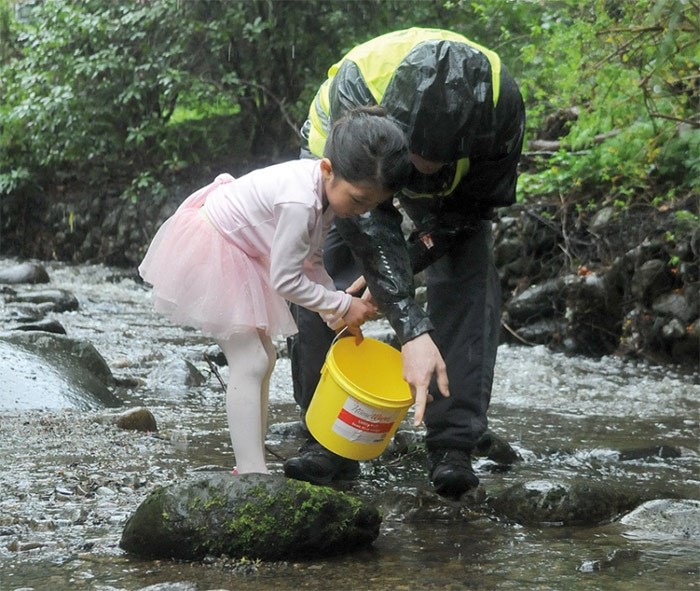 Five-year-old Urara Nakamori prepares to release coho smolt into McDonald Creek, part of the West Â鶹´«Ă˝Ół»Streamkeeper Society’s Adopt-a-fish program in partnership with the Coho Society of North Shore. photo Mike Wakefield, North Shore News
Five-year-old Urara Nakamori prepares to release coho smolt into McDonald Creek, part of the West Â鶹´«Ă˝Ół»Streamkeeper Society’s Adopt-a-fish program in partnership with the Coho Society of North Shore. photo Mike Wakefield, North Shore News
Local streamkeeper volunteers are hoping some recent die-offs of cutthroat trout in local streams will become a teachable moment for residents who may have become complacent in protecting fish habitat.
Damages are still being assessed after apparent chemical spills killed dozens of cutthroat trout in Mackay Creek in North Â鶹´«Ă˝Ół»and Woods Creek in West Vancouver, and charges are possible following a deadly spill of construction debris in Larson Creek near Horseshoe Bay.
“Obviously, nobody wants this to happen. It’s about informing people about the connection between our creeks and our storm drains,” said Ron den Daas, of North Shore Streamkeepers.
The Department of Fisheries and Oceans publishes a pamphlet reminding folks of best practices for keeping our streams healthy. Much of it involves making sure our storm drains are reserved for storm water. Household chemicals and debris from our vehicles are major concerns.
“Dispose of unused paint and chemicals correctly. Never dump into household toilets and sinks or outside ditches, storm drains or streams,” DFO advises. “Oil, antifreeze and contaminants from car exhaust will kill fish when washed off roads into storm drains and streams. Fix oil and transmission leaks. Place a drip tray under the car. Never dispose of used oils and antifreeze into gutters or storm drains, all of which empty into streams.”
Cars should be washed with minimal detergent and, where possible, only on gravel or lawns and wash water should be kept out of the gutter. Residents should sweep their walks and drives rather than hose them down. The surfaces we choose for our yards can also make a big difference. The less paving, the better. Porous asphalts, paving stones or bricks for driveways are preferred, according to DFO.
“During construction projects, keep wet concrete from storm drains and streams. It is very toxic to fish and other wildlife,” DFO states.
In the garden, we should be mindful that anything dangerous to pests and weeds is also dangerous to fish habitat. Spraying should only be done on windless days and not before or during rain. Garden waste should also be kept away from watercourses and our domestic critters can be a threat too.
“Keep pets away from streams. Animal waste is polluting. Pets entering streams can erode stream banks and cause siltation; their activity also disturbs wildlife and salmon living in streams,” DFO states.
Getting more people following those guidelines could make a major difference, den Daas said.
“There are a whole number of reasons to be concerned on various levels. These are little spills but they’re happening on all the creeks and rivers across the North Shore. It’s a death by a thousand cuts kind of story,” he said.


